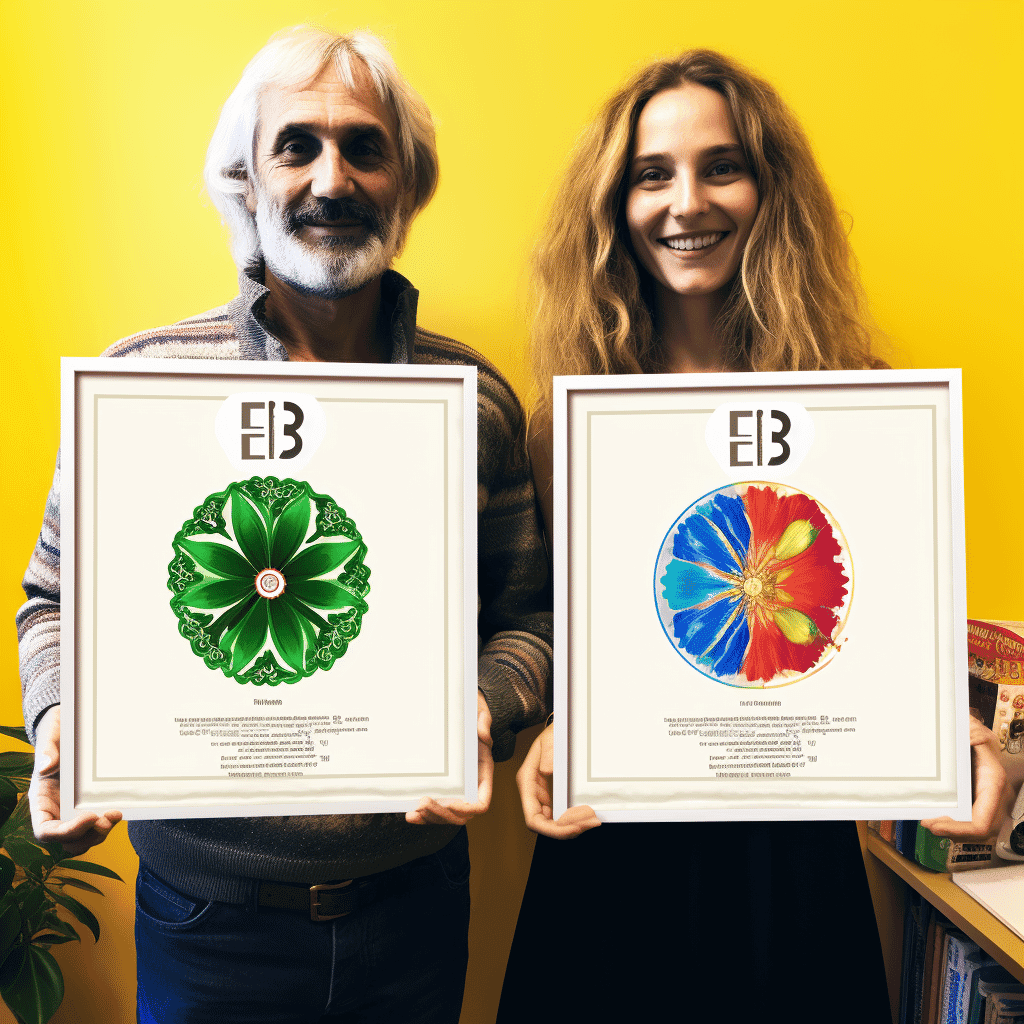Descrição
How does the choice of 1st and 2nd course options work in the entrance exam
When the time comes to take the entrance exam, one of the most important decisions students have to make is choosing their 1st and 2nd course options. This decision can directly influence each student's academic and professional future. In this blog, we will explain how this process works and give some tips to help you choose.
What are the 1st and 2nd course options?
The 1st course option is the one the student most wants to enroll in. It is the course they are most interested in and have the most affinity for, and the one they would like to take if they are accepted into the entrance exam. The 2nd course option is an alternative if the student is not accepted into their first choice. It is important to choose a second option that is also of interest, so that the student is motivated to take it if necessary.
How does the choice of the 1st and 2nd course option work in the entrance exam?
When registering for the entrance exam, the student must select which will be his/her 1st and 2nd course option. It is important to research the universities and courses available, to make an informed choice that is aligned with your interests and aptitudes.
After the tests are taken, the grades are released and the students are classified according to the score obtained. Those who reach the cutoff grade for the 1st course option are approved and enrolled. Students who do not meet the cutoff grade for their first option, but meet the cutoff grade for their second option, are approved and enrolled in their second choice.
Tips for choosing your first and second course options
- Reflect on your interests, skills and aptitudes. Think about what you like to do and what you find easy.
- Research professions and careers related to the courses you are interested in. Talk to professionals in the field and seek information about the job market.
- Analyze the curriculum of the courses you are considering. Check whether the subjects are attractive to you and whether they are aligned with your goals.
- Consider your financial and geographic possibilities. Check whether the course you choose is available in the region where you intend to study and whether you will be able to afford the costs.
- Don't worry about choosing the option that seems most "prestigious" or "valued". The most important thing is to choose something that you really like and have an affinity for.
Remember that choosing the 1st and 2nd course option is a personal and unique decision. Each student has their own motivations and interests, and it is important to respect that. The most important thing is to seek information, reflect and make a conscious choice, which is aligned with your goals and happiness.
| Benefits of choosing the 1st and 2nd course option carefully |
|---|
| Personal fulfillment: By choosing a course that you really like, you will have more motivation and satisfaction during your undergraduate years. |
| Better opportunities: By dedicating yourself to a course that you have an affinity with, you will have more chances of standing out and getting good opportunities in the job market. |
| Less chances of giving up: When we choose something that we really like, we are more willing to face the challenges and overcome the difficulties that may arise during the graduation. |
In short, choosing your 1st and 2nd course option in the entrance exam is an important step in any student's life. It is essential to research, reflect and choose something that is aligned with your interests and goals. Remember that this choice can directly influence your academic and professional future. Therefore, do it carefully. Be careful and trust your intuition!
How do 1st and 2nd course options work in the entrance exam
When the time comes to decide which college course to pursue, many students are faced with the option of choosing a first and second course option in the entrance exam. But after all, how does this choice work and what are the consequences of it? In this article, we will explore this topic and clarify some common doubts.
First course option
The first course option is the one that the student most wants to enroll in. It is the course that he or she is most interested in and believes to be the most suitable for his or her professional career. By choosing this option, the student is indicating that, if approved, this is the course that he or she intends to enroll in.
It is important to emphasize that the first course option takes priority over the second option. In other words, if the student is accepted for the first option, he/she cannot be called for the second option, even if there are vacancies available.
Second course option
The second course option is an alternative that the student chooses if he/she is not accepted for the first option. It is a way of ensuring that, even if he/she is not able to get into the desired course, he/she will still have the opportunity to study at the university.
If the student is accepted for the second option, he/she can choose between enrolling in that course or waiting for a possible call for the first option. If he/she chooses to enroll in the second option, he/she can no longer be called for the first option, even if there are vacancies available.
Consequences of the choice
Choosing the first and second course options in the entrance exam can have some important consequences. For example, if a student is accepted into their first option but chooses to enroll in their second option, they will lose their place in their first option and will no longer be able to apply for it.
In addition, it is important to consider that the second course option may be a temporary choice, while the student awaits a possible call for their first option. Therefore, it is essential that the student is truly interested and willing to take the second option, if necessary.
Conclusion
Choosing the first and second course options in the entrance exam is an important decision that can have significant consequences. It is essential that the student reflects on their interests, skills and expectations before making this choice. In addition, it is essential to be aware of the possible consequences and be prepared to deal with them.
We hope that this article has clarified your doubts about how choosing the first and second course options in the entrance exam works. If you have any further questions or would like to learn more about this topic, check out the links below:
- Sitelinks
- Reviews
- People also ask
- Knowledge panel
- FAQ
- Top stories
- Recipes
- Find results on
- See results about
- Related searches
We hope you are successful in your choice and good luck in the entrance exam!
What is the 1st and 2nd course option and how does it work in the entrance exam?
When the time comes to take the entrance exam, many students are faced with the need to choose a 1st and 2nd course option. This choice can generate doubts and uncertainties, but it is important to understand how this process works in order to make an informed decision.
1st course option
The 1st course option is the one that the student most desires to enroll. This is the course that interests the student the most and that he or she considers to be his or her first choice. If he or she is accepted for this option, he or she will be automatically enrolled in it.
It is important to emphasize that the 1st course option must be chosen carefully, taking into account the student's profile, skills and interests. It is recommended to research the course, curriculum, job market and career possibilities before making this decision.
2nd course option
The 2nd course option is an alternative if the student is not accepted for his or her 1st option. If it is not possible to enroll in the desired course, he or she will be automatically considered for the 2nd option, provided that he or she has achieved the minimum grade required.
It is important to choose a 2nd course option that is also of interest to the student. Therefore, if it is not possible to enroll in the first option, the student will have an alternative that is still aligned with their interests and goals.
How the selection process works
When registering for the entrance exam, the student will have the opportunity to choose their 1st and 2nd course option. This choice is usually made through an online form, where the student selects the desired courses.
It is important to pay attention to the deadlines established by the educational institution, since the choice of course options is usually made before the entrance exams are held.
After the results are released, the student will be able to check whether they were approved for their 1st course option. If the candidate is not approved, he/she will automatically be considered for the 2nd option, as long as he/she has achieved the minimum grade required.
It is important to note that choosing the 2nd course option does not prevent the student from trying to enroll in his/her 1st option again in future selection processes.
Sitelinks
Sitelinks are additional links that appear below the main result of a website in search engines. They help users navigate directly to specific pages within the website.
Reviews
Reviews are evaluations made by users about a specific product, service or company. They can appear in search results and help users make informed decisions based on other people's experiences.
People also ask
The "People also ask" section displays questions related to the term searched by users. These questions are frequently asked by other people and can provide additional information about the topic.
Knowledge panel
The knowledge panel is an information box that appears in search results and provides a summary of a specific person, place, or thing. It can include details such as a description, images, biographical data, and more.
FAQ
The FAQ (Frequently Asked Questions) section presents frequently asked questions and their answers related to the searched topic. This section helps users find relevant information quickly and easily.
Top stories
The "Top stories" section displays the latest and most relevant news related to the search term. This section is constantly updated and helps users stay informed about the latest happenings.
Recipes
The recipes section presents recipes related to the search term. This section is useful for users who are looking for culinary inspiration or want to learn how to prepare a specific dish.
Find results on
The "Find results on" section displays links to other search engines where users can find additional results for the search term. This allows for a more comprehensive and in-depth search.
See results about
The "See results about" section displays links to other terms related to the search topic. This allows users to broaden their search uisa and find additional information on related topics.
Related searches
The "Related searches" section displays search terms related to the subject searched. These terms can be useful for users who want to refine their search or explore related topics.
When choosing your 1st and 2nd course options for the entrance exam, it is important to consider your interests, aptitudes and goals. Researching the desired courses, understanding how the selection process works and being aware of the career possibilities are fundamental steps to making an informed decision. Remember that choosing your 2nd option does not prevent you from trying again to enter your 1st option in future selection processes. Good luck!
What is the best course option? How do 1st and 2nd options work in the entrance exam?
When it comes time to choose a course to enter university, many students are faced with the question: what is the best course option? In addition, it is important to understand how choosing the first and second options in the entrance exam works. In this article, we will explore these questions and provide useful information to help in the decision-making process.
How does choosing the first and second options work in the entrance exam?
In the entrance exam selection process, it is common for candidates to have the possibility of choosing a first and a second course option. This choice is important, because if the student is not approved for the first option, he or she may be called for the second option, as long as there are vacancies available.
It is essential to research and know the courses of interest well before making this choice. Analyzing the curriculum, the possibilities for professional development, the reputation of the educational institution and the opportunities offered by the course are some of the aspects to be considered.
What is the best course option?
There is no single answer to this question, as the best course option varies according to the interests, skills and objectives of each student. What may be ideal for one person may not be for another.
It is important to take into account your profile, your skills and your passions. Ask yourself: what area sparks my interest? What area do I see myself working in in the future? What are my skills and how can I develop them further?
In addition, it is worth seeking information about the job market and the prospects for each area. Talk to professionals who work in the area of your interest, research job opportunities and career growth possibilities.
Remember: choosing a course is a personal decision and should be made carefully and thoughtfully. Don't let yourself be influenced by other people's opinions; seek to know yourself and make a choice that is aligned with your goals and values.
Sitelinks
Sitelinks are additional links that appear below a website's main result in search results. They provide quick access to relevant internal pages on the website, making navigation easier for the user.
Reviews
Reviews are evaluations made by users about a specific product, service or company. They can be found in search results and help users make informed decisions based on the experiences of others.
People also ask
The "People also ask" section displays questions related to the search term. These are questions that are frequently asked by users and provide quick, relevant answers to their questions.
Knowledge panel
The knowledge panel is an information box that appears in search results and provides a summary of a specific entity, such as a person, place, or organization. It displays important information such as a description, contact information, and related links.
p>FAQ
The FAQ (Frequently Asked Questions) section presents frequently asked questions and their answers related to the searched topic. This section is useful for users who want to get quick and direct information on a particular topic.
Top stories
The "Top stories" section displays the latest and most relevant news related to the searched term. This section is constantly updated and provides users with quick access to the latest information on a particular topic.
Recipes
The recipes section displays recipes related to the searched term. This section is useful for users who are looking for culinary inspiration or step-by-step instructions for preparing a particular dish.
Find results on
The "Find results on" option allows users to find search results on a specific website. This is useful when you want to search for information within a specific website, rather than across the entire web.
See results about
The "See results about" option displays search results related to a specific term. This is useful when you want to explore different aspects or perspectives of a particular topic.
Related searches
The "Related searches" section displays search terms related to the search term. These terms are useful for users who want to refine their search or explore related topics.
Conclusion
Choosing a course for college entrance exams is an important and personal decision. There is no one course option that is best for everyone, as each person has different interests, skills, and goals. It is essential to research, reflect, and seek relevant information before making this decision. Use the SERP features mentioned to obtain additional information and make an informed decision. Good luck on your academic journey!
What is the purpose of choosing the 1st and 2nd course option in the entrance exam?
When it comes time to choose a course to enter university, many students are faced with the option of choosing a first and second course option in the entrance exam. But after all, what is this choice for and how does it work?
How does choosing the first and second course option work in the entrance exam?
When registering for the entrance exam, it is common for higher education institutions to ask the candidate to choose a first and second course option. This choice is important because, if the candidate is not approved for their first option, they may be called for the second chosen option.
It is important to emphasize that the second course option will only be considered if there are remaining vacancies after the call for those approved for the first option. Therefore, it is essential that the student chooses a second option that is also of interest to them and is in line with their skills and abilities.
What is the purpose of choosing the first and second course options in the entrance exam?
Choosing the first and second course options in the entrance exam serves to ensure that the student has a second chance if they are not accepted into their first option. This prevents them from being left without any course options if they are not classified.
In addition, this choice is also important for educational institutions, as it allows them to have an idea of the demand for each course. Based on the candidates' choices, universities can plan the opening of new classes and the distribution of vacancies.
Sitelinks
Sitelinks are additional links displayed in Google search results that direct the user to specific pages within a website. In the case of this blog, sitelinks can take the reader to other related posts about college entrance exams and university courses.
Reviews
Reviews are evaluations made by users about a certain product or service. In the case of this blog, sitelinks can take the reader to other related posts about college entrance exams and university courses.
In the text of this blog, reviews of university courses could be included, where students share their experiences and opinions about the quality of the education offered.People also ask
The "People also ask" section displays questions related to the researched topic and their answers. This blog could include questions such as "What are the advantages of choosing a second course option?" or "How does the call for the second course option in the entrance exam work?".
Knowledge panel
The knowledge panel is an information box displayed in Google search results that provides relevant data on a given subject. In the case of this blog, a knowledge panel could be included with general information about the process of choosing the first and second course options in the entrance exam.
FAQ
The FAQ (Frequently Asked Questions) section could be included in this blog to answer the most common questions readers have about choosing the first and second course options in the entrance exam.
Top stories
The "Top stories" section displays the most relevant news about a given subject. This blog could include news related to choosing courses in the entrance exam, such as changes in selection rules or testimonials from students who were accepted into their first or second choices.
Recipes
The "Recipes" section is generally used to display culinary recipes in search results. In the context of this blog, it would not be relevant to include this SERP feature.
Find results on
The SERP feature "Find results on" allows the user to find search results on a specific website. In this blog, this feature could be included so that the reader can find more information about the selection process of a certain university.
See results about
The SERP feature "See results about" displays search results related to a certain topic. In this blog, results about the importance of choosing the second option of course in the entrance exam or testimonials from students who were called for the second option could be included.
Related searches
The "Related searches" section displays searches related to the topic searched. In this blog, searches such as "How to choose the second option of course in the entrance exam?" could be included. or "What are the chances of being called for the second course option?".
Conclusion
Choosing the first and second course options in the entrance exam is a strategy that aims to guarantee a second chance for students and also help educational institutions in the distribution of vacancies. It is important that the candidate chooses a second option that is of interest to them and is aligned with their skills. Through the SERP features mentioned, it is possible to obtain more information and clarify doubts about this process.
Who can do it? How does the 1st and 2nd course option work in the entrance exam?
When the time comes to decide which university course to follow, many students are faced with the doubt about how the 1st and 2nd option options work in the entrance exam. In this article, we will explain in detail who can make these choices and how they work.
Who can make the 1st and 2nd course option in the entrance exam?
The 1st and 2nd course option in the entrance exam is a possibility offered by some universities to candidates. Generally, this option is available in selection processes that use the Unified Selection System (Sisu) or the University for All Program (ProUni).
Any student who is participating in these selection processes can make the 1st and 2nd course option. However, it is important to note that each university has its own rules and criteria for using this option.
How do the 1st and 2nd course option work in the entrance exam?
When registering In the entrance exam, the candidate has the possibility of choosing two different courses, the first being their 1st option and the second as their 2nd option. This choice is made according to the student's preference and their academic interests.
If the candidate is approved for their 1st course option, they will automatically be enrolled in that degree. However, if there are not enough places available or if the candidate does not reach the cutoff grade, they may be called for their 2nd course option, if there are places available.
It is important to note that the 2nd course option will only be considered if the candidate is not approved for their 1st option. Otherwise, he will not have the chance to be called for his second choice.
Sitelinks:- Who can choose the 1st and 2nd course option in the entrance exam?
- How do the 1st and 2nd course options work in the entrance exam?
The option of choosing two courses in the entrance exam is very useful for students, as it increases their chances of getting into university. Furthermore, it allows the candidate to explore different areas of interest and have a second option if they are not accepted in their first choice.
People also ask:- Which universities offer the option of 1st and 2nd choice of course in the entrance exam?
- Is it possible to choose courses from different areas as 1st and 2nd option?
- If I am accepted in my 1st option, can I give up and choose the 2nd option?
The 1st and 2nd choice course system in the entrance exam is a way to facilitate the student selection process and ensure that everyone has a chance of entering the university. It is important that candidates are aware of the rules and criteria of each institution in order to make the best use of this option.
FAQ:- Which universities offer the option of 1st and 2nd choice of course in the entrance exam? Some universities that offer this option are: Universidade Federal do Rio de Janeiro (UFRJ), Universidade de São Paulo (USP), Universidade Estadual de Campinas (Unicamp), among others.
- Is it possible to choose courses from different areas as 1st and 2nd option? Yes, it is possible to choose courses from different areas as 1st and 2nd option, as long as the university allows this flexibility.
- If I am accepted for my 1st option, can I withdraw and choose the 2nd option? No, if you are accepted for your 1st option, you cannot withdraw and choose the 2nd option. The 2nd option will only be considered if you are not accepted into your first choice.
Check out the latest news about the 1st and 2nd choice course option in the entrance exam and stay up to date with the latest news and changes in university rules.
Recipes:Not applicable to the topic.
Find results on:To find more information about the 1st and 2nd choice course option in the entrance exam, you can check the websites of the universities you are interested in enrolling in.
See results about:See more results about the 1st and 2nd choice course option in the entrance exam and understand how this possibility can influence your academic trajectory.
Related searches:- How does Sisu work?
- What are the criteria for admission to a university through ProUni?
- What are the cutoff grades for the most popular courses?
We hope this article has clarified your doubts about who can take the 1st and 2nd course option in the entrance exam and how this option works. Remember to always check the rules and criteria of the universities you intend to apply to in order to be well informed and increase your chances of admission. only in the desired degree.
How long does an entrance exam course last?
When it comes to choosing a course to enter higher education, it is common to have doubts about the duration of the courses and how they work. In this article, we will address the duration of an entrance exam course, both for the first option and the second option.
Duration of entrance exam courses
The duration of an entrance exam course may vary according to the area of study and the educational institution. Generally, undergraduate courses last an average of 4 to 6 years, divided into semesters or quarters.
Bachelor's degrees, such as Engineering, Law and Administration, usually last 4 to 5 years. Degree courses, such as Pedagogy and Literature, have an average duration of 4 years. Technological courses, more focused on technical training, last on average 2 to 3 years.
First course option in the entrance exam
When you register for the entrance exam, you must choose a first course option. If approved, you will be enrolled in this course and must follow the curriculum established by the educational institution.
It is important to highlight that the duration of the course is not affected by choosing the first option. Regardless of the course chosen, the duration will be the same, as mentioned previously.
Sitelinks:- Duration of courses in the entrance exam
- First option of course in the entrance exam
- Second course option in the entrance exam
- Conclusion
Second course option in the entrance exam
In addition to the first course option, many institutions allow you to choose a second option. If you do not pass the first option, but pass the second option, you will be enrolled in this course.
The duration of the course will also be the same, regardless of choosing the second option. However, it is important to highlight that the curriculum may be different from the first option, as each course has specific subjects.
Sitelinks:
- Duration of courses in the entrance exam
- First option of course in the entrance exam
- Second course option in the entrance exam
- Conclusion
Conclusion
In summary, the duration of an entrance exam course varies according to the area of study and the educational institution. Regardless of choosing the first or second course option, the duration will be the same. It is important to research the curriculum and subjects offered to make a conscious decision that is aligned with your interests and professional goals.
We hope this article has clarified your doubts about the duration of the entrance exam courses. If you have more questions, check out the frequently asked questions (FAQ) and related search sections for more information.
FAQ:- How long does an Engineering course last?
- How long is a Pedagogy course?
- Can I change course after passing the entrance exam?
- How does the entrance exam work?
- What are the types of courses in the entrance exam?
- What are the areas of study in higher education?
How much does an entrance exam cost?
If you are thinking about enrolling in a university course, it is natural that one of your concerns is the cost of this training. In this article, we will talk about about the values involved in a course in the entrance exam, both in the first option
Estimar frete
Payment & Security

Featured collection





















![Curso de Angular e NodeJS - O Guia da Pilha MEAN [Edição 2023] - IBRATH Instituto Brasileiro de Terapias Holísticas teste011020230809](http://enciclopedia.paginasdabiblia.com/cdn/shop/products/a19556.png?v=1699935448&width=1024)




![Curso de Docker & Kubernetes: O Guia Prático [Edição 2023] - IBRATH Instituto Brasileiro de Terapias Holísticas teste011020230809](http://enciclopedia.paginasdabiblia.com/cdn/shop/products/a19570.png?v=1699935525&width=1024)





















Dúvidas Gerais
Após a confirmação do pagamento, você receberá um e-mail com todas as instruções para acessar seus cursos. O e-mail incluirá um link para a plataforma de ensino, onde você poderá fazer login utilizando suas credenciais cadastradas no momento da compra. Caso seja um curso em formato de arquivo para download, o mesmo estará disponível na área do aluno e poderá ser acessado diretamente pelo link enviado. Se você não receber o e-mail de acesso em até 24 horas, verifique sua caixa de spam ou entre em contato com nossa equipe pelo e-mail suporte@amentil.com.br.
Após a confirmação do pagamento, seu pedido será processado e enviado para o endereço cadastrado. Você receberá um e-mail com os detalhes do envio, incluindo o código de rastreamento para acompanhar a entrega. Trabalhamos com transportadoras confiáveis e os prazos variam de acordo com o método de envio escolhido e sua localização. É importante garantir que o endereço de entrega esteja correto para evitar atrasos. Caso tenha dúvidas ou problemas com a entrega, nossa equipe de suporte está à disposição pelo e-mail suporte@amentil.com.br.
Você pode tirar dúvidas diretamente com nossa equipe de suporte por diversos canais:
- E-mail: Envie sua pergunta para suporte@amentil.com.br, e nossa equipe responderá em até 2 dias úteis.
- Telefone: Ligue para +55 (48) 1234-5678, disponível de segunda a sexta, das 9h às 18h.
- WhatsApp: Envie uma mensagem para +55 (48) 91265-4321 e receba atendimento rápido e prático.
- Formulário de Contato: Preencha o formulário disponível em nosso site na página Contato.
- Redes Sociais: Você também pode enviar suas dúvidas pelo Instagram ou Facebook em @amentil.sa.
Estamos sempre prontos para ajudar!
Reembolso e garantias
O prazo de reembolso pode variar dependendo da forma de pagamento utilizada:
- Cartão de Crédito: O estorno será realizado em até 7 dias úteis após a aprovação do reembolso, mas o crédito poderá aparecer na sua fatura em um prazo de 30 a 60 dias, conforme a política da operadora do cartão.
- Boleto Bancário ou Transferência: O valor será devolvido via depósito em conta bancária em até 7 dias úteis após a aprovação do reembolso.
Você pode solicitar a devolução de produtos físicos seguindo o passo a passo abaixo:
- Entre em contato com nosso suporte:
- Aguarde nossa resposta:
Nossa equipe analisará sua solicitação em até 3 dias úteis e fornecerá as instruções detalhadas para a devolução. - Prepare o produto:
- Envie o produto:
- Reembolso ou troca:
Nosso compromisso é fornecer uma experiência confiável e segura ao acessar nossa enciclopédia online. Garantimos a qualidade dos serviços e funcionalidades oferecidos, seguindo as condições descritas abaixo:
1. Garantia de Acesso
- Disponibilidade: Oferecemos garantia de disponibilidade da enciclopédia online 24 horas por dia, 7 dias por semana, exceto durante períodos programados de manutenção ou por problemas técnicos fora do nosso controle.
- Resolução de Problemas: Em caso de interrupções no serviço, nossa equipe técnica atuará para restaurar o acesso no menor tempo possível.
2. Garantia de Conteúdo
- Precisão e Atualização: Todo o conteúdo disponibilizado é cuidadosamente revisado para garantir precisão e relevância. No entanto, a enciclopédia online é constantemente atualizada, e não podemos garantir a exatidão absoluta em casos de informações sujeitas a mudanças rápidas.
- Correção de Erros: Caso identifique erros ou inconsistências no conteúdo, você pode nos informar pelo e-mail conteudo@amentil.com.br, e faremos a análise e correção, se necessário.
3. Garantia de Segurança
- Proteção de Dados: Utilizamos tecnologias avançadas para proteger suas informações pessoais e garantir que sua navegação na enciclopédia seja segura.
- Privacidade: Todos os dados coletados seguem as diretrizes da nossa Política de Privacidade.
4. Garantia de Reembolso
Para assinaturas da enciclopédia online:
- Direito de Arrependimento: Você pode solicitar o cancelamento e reembolso integral em até 7 dias corridos após a compra, desde que não tenha acessado conteúdos pagos da plataforma.
- Problemas Técnicos: Caso não consiga acessar os conteúdos devido a falhas técnicas imputáveis à plataforma, garantimos suporte prioritário e, se o problema não for resolvido, você pode solicitar reembolso proporcional ao período não utilizado.
5. Limitações
- Conexão à Internet: Não garantimos acesso à enciclopédia em situações de instabilidade ou falhas na conexão de internet do usuário.
- Uso Indevido: O acesso e uso da enciclopédia são pessoais e intransferíveis. O compartilhamento de credenciais pode resultar na suspensão ou cancelamento da assinatura sem reembolso.
6. Contato para Garantias
Caso precise de suporte ou queira exercer algum direito de garantia, entre em contato conosco:
- E-mail: suporte@amentil.com.br
- Telefone: +55 (48) 1234-5678
- Horário de atendimento: Segunda a sexta, das 9h às 18h.



